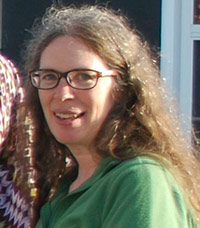
Name: Kathy Cosenza
Education: B.S. General Biology at Portland State University; M.S. in Physical Therapy at Pacific University; B.S. in Microbiology at Colorado State University; PhD in Cellular and Molecular Biology at Colorado State University.
Hometown: Astoria, Oregon
Career goal: Teach at a community college.
Favorite Memory: Achieving success at different stages of her current experiment. “To work hard for months going through all the manipulations and everything, sometimes you don’t really get feedback: ‘Is what I want in this tube really in this tube?’” Kathy recalls.“I remember one time when we went to take a picture and I wasn’t expecting good results, and we looked at it and there’s a band of exactly the right size of what could be there. And, you should have seen us! There were two of us, an undergrad and I, and we were just excited, jumping up and down, high-fiving.”
Project: Regulation of myostatin and mechanistic target of rapamycin (mTOR) signaling genes by molting hormone (ecdysteroids) in the skeletal muscles of decapod crustaceans
Kathy studies genes that regulate growth in the green shore and the land crab and the hormones that in turn regulate the genes. The gene Myostatin inhibits muscle growth, and Kathy wants to understand how ecdysteroid hormones regulate myostatin. This project broadens scientific knowledge of how crabs control growth. A part of the Myostatin gene called the promoter initiates transcription, or copying, of the gene. Kathy took the promoter section of the Myostatin gene and attaches it in front of a glowing luciferase gene in a plasmid, a small DNA molecule, to test the effectiveness of the promoter section. A strong promoter produces lots of luciferase, which creates lots of glow. A plasmid without the promoter section won’t produce any luciferase and won’t glow. From her experiments, Kathy notices that the Myostatin promoter fell in between the extremes.
Kathy also determines how ecdysteroids themselves affect the gene. Ecdysteroids help control a gene by binding to a specialized area called an ecdysone response element. Kathy adds the ecdysone element to a plasmid with a promoter and observes how adding different amounts of ecdysteroids affect the amount of the glowing luciferase. She also adds ecdysteroids to the plasmids without the ecdysones. Initial results show that the ecdysteroids do affect Myostatin’s effectiveness and that the ecdysone response element plays a role in producing products.
